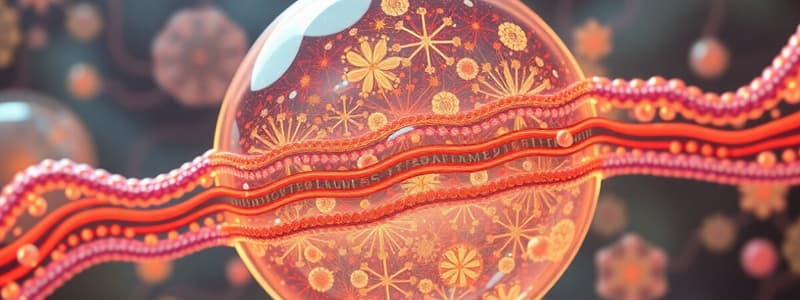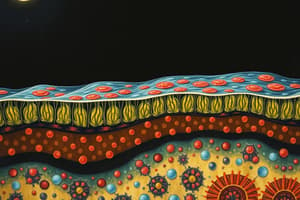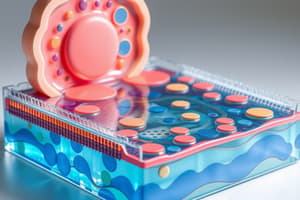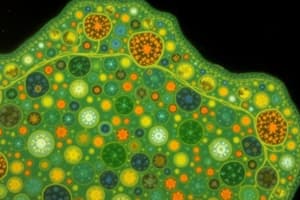Podcast
Questions and Answers
Which of the following is NOT a function of the cell membrane?
Which of the following is NOT a function of the cell membrane?
- Maintaining a mechanical barrier between the cell's interior and external environment
- Providing a framework for the cell's shape and structure
- Regulating the passage of water-soluble substances through the membrane
- Synthesizing proteins and lipids for the cell's use (correct)
Which of the following statements about the fluid mosaic model of the cell membrane is TRUE?
Which of the following statements about the fluid mosaic model of the cell membrane is TRUE?
- It emphasizes that the membrane is a fluid structure with lipids and proteins constantly moving and interacting. (correct)
- It describes a static, rigid structure with phospholipids forming a tightly packed, impermeable layer.
- It suggests that the membrane is composed of a single layer of phospholipids with proteins attached to its outer surface.
- It postulates that proteins are embedded in a rigid lipid matrix that restricts their movement.
Which type of cell junction is responsible for preventing the leakage of substances between cells?
Which type of cell junction is responsible for preventing the leakage of substances between cells?
- Gap junctions
- Tight junctions (correct)
- Cell adhesion molecules
- Desmosomes
Which of the following is NOT a function of the extracellular matrix (ECM)?
Which of the following is NOT a function of the extracellular matrix (ECM)?
Which component of the cell membrane plays a crucial role in maintaining the fluidity and stability of the membrane?
Which component of the cell membrane plays a crucial role in maintaining the fluidity and stability of the membrane?
Which of the following is NOT a type of protein found in the cell membrane?
Which of the following is NOT a type of protein found in the cell membrane?
What is the primary function of the glycocalyx on the cell surface?
What is the primary function of the glycocalyx on the cell surface?
Which type of cell junction allows for direct communication and exchange of small molecules between adjacent cells?
Which type of cell junction allows for direct communication and exchange of small molecules between adjacent cells?
What is the primary reason for the generation of resting membrane potential (RMP)?
What is the primary reason for the generation of resting membrane potential (RMP)?
What does a negative membrane potential of −70mV indicate about the charges inside and outside the cell?
What does a negative membrane potential of −70mV indicate about the charges inside and outside the cell?
How does the Na-K-ATPase pump contribute to the maintenance of membrane potential?
How does the Na-K-ATPase pump contribute to the maintenance of membrane potential?
What is the equilibrium potential for K+ (EK+) calculated based on the provided concentration values?
What is the equilibrium potential for K+ (EK+) calculated based on the provided concentration values?
Which ion's permeability has the highest relative value in the resting state according to the provided data?
Which ion's permeability has the highest relative value in the resting state according to the provided data?
What does the Nernst equation express in the context of membrane potential?
What does the Nernst equation express in the context of membrane potential?
Why is the equilibrium potential for Na+ (ENa+) lower than that for K+ (EK+)?
Why is the equilibrium potential for Na+ (ENa+) lower than that for K+ (EK+)?
What is the significance of the leak channels for Na+ and K+ ions in the generation of RMP?
What is the significance of the leak channels for Na+ and K+ ions in the generation of RMP?
What type of communication involves hormones secreted into the blood that act on distant target cells?
What type of communication involves hormones secreted into the blood that act on distant target cells?
Which type of ion channel opens in response to changes in the electrical status of the plasma membrane?
Which type of ion channel opens in response to changes in the electrical status of the plasma membrane?
What characterizes water-soluble chemical messengers during signal transduction?
What characterizes water-soluble chemical messengers during signal transduction?
Which of the following is an example of a second messenger in signal transduction pathways?
Which of the following is an example of a second messenger in signal transduction pathways?
What process describes the way a chemical signal is converted or transduced inside a cell?
What process describes the way a chemical signal is converted or transduced inside a cell?
What is the primary function of receptor binding in the context of signal transduction?
What is the primary function of receptor binding in the context of signal transduction?
What distinguishes autocrine communication from paracrine communication?
What distinguishes autocrine communication from paracrine communication?
Which of the following best describes the role of transducers in signal transduction?
Which of the following best describes the role of transducers in signal transduction?
Which structure is responsible for the 'spot rivets' found in desmosomes?
Which structure is responsible for the 'spot rivets' found in desmosomes?
In which junctions do cells adhere firmly and form seals at specific sites?
In which junctions do cells adhere firmly and form seals at specific sites?
What is the main function of gap junctions?
What is the main function of gap junctions?
What defines the movement of particles during passive transport?
What defines the movement of particles during passive transport?
What is the primary mechanism through which water moves across a semi-permeable membrane?
What is the primary mechanism through which water moves across a semi-permeable membrane?
Which of the following factors is NOT one that influences the rate of diffusion?
Which of the following factors is NOT one that influences the rate of diffusion?
What type of transport applies when materials move through a cell membrane using energy?
What type of transport applies when materials move through a cell membrane using energy?
What accurately describes the nature of tight junctions?
What accurately describes the nature of tight junctions?
How do cations move in response to an electrochemical gradient?
How do cations move in response to an electrochemical gradient?
What happens when osmotic pressure is balanced by opposing hydrostatic pressure?
What happens when osmotic pressure is balanced by opposing hydrostatic pressure?
What is a key characteristic of facilitated diffusion?
What is a key characteristic of facilitated diffusion?
Which transport mechanism involves movements using membrane vesicles?
Which transport mechanism involves movements using membrane vesicles?
What is primarily moved during osmosis?
What is primarily moved during osmosis?
Which of the following statements about carrier-mediated transport is NOT true?
Which of the following statements about carrier-mediated transport is NOT true?
Which of the following is a characteristic of facilitated diffusion?
Which of the following is a characteristic of facilitated diffusion?
The Na+/K+ ATPase pump is an example of which type of transport?
The Na+/K+ ATPase pump is an example of which type of transport?
Which of the following statements about secondary active transport is TRUE?
Which of the following statements about secondary active transport is TRUE?
Which type of endocytosis is responsible for the uptake of specific, large molecules?
Which type of endocytosis is responsible for the uptake of specific, large molecules?
Which of the following is NOT a characteristic of exocytosis?
Which of the following is NOT a characteristic of exocytosis?
Which of the following types of cell-cell communication is considered the most intimate and rapid?
Which of the following types of cell-cell communication is considered the most intimate and rapid?
Which of the following is NOT a characteristic of gap junctions?
Which of the following is NOT a characteristic of gap junctions?
Which of the following statements about juxtacrine communication is TRUE?
Which of the following statements about juxtacrine communication is TRUE?
Which of the following correctly pairs a type of cell communication with its primary function?
Which of the following correctly pairs a type of cell communication with its primary function?
Flashcards
Osmolarity
Osmolarity
The concentration of all solutes (both penetrating and non-penetrating) in a solution.
Tonicity
Tonicity
The concentration of only non-penetrating solutes in a solution.
Carrier-Mediated Transport
Carrier-Mediated Transport
A type of membrane transport that utilizes carrier proteins to move substances across the membrane.
Specificity and Selectivity in Carrier-Mediated Transport
Specificity and Selectivity in Carrier-Mediated Transport
Signup and view all the flashcards
Saturation in Carrier-Mediated Transport
Saturation in Carrier-Mediated Transport
Signup and view all the flashcards
Competition in Carrier-Mediated Transport
Competition in Carrier-Mediated Transport
Signup and view all the flashcards
Facilitated Diffusion
Facilitated Diffusion
Signup and view all the flashcards
Primary Active Transport
Primary Active Transport
Signup and view all the flashcards
Secondary Active Transport
Secondary Active Transport
Signup and view all the flashcards
Vesicular Transport
Vesicular Transport
Signup and view all the flashcards
What is the function of the cell membrane?
What is the function of the cell membrane?
Signup and view all the flashcards
What are the main components of the cell membrane?
What are the main components of the cell membrane?
Signup and view all the flashcards
How are proteins arranged within the cell membrane?
How are proteins arranged within the cell membrane?
Signup and view all the flashcards
Describe the functions of different types of membrane proteins.
Describe the functions of different types of membrane proteins.
Signup and view all the flashcards
What is the role of carbohydrates in the cell membrane?
What is the role of carbohydrates in the cell membrane?
Signup and view all the flashcards
Explain the fluid mosaic model of the cell membrane.
Explain the fluid mosaic model of the cell membrane.
Signup and view all the flashcards
What are the three main types of specialized cell junctions?
What are the three main types of specialized cell junctions?
Signup and view all the flashcards
What is the extracellular matrix and what are its functions?
What is the extracellular matrix and what are its functions?
Signup and view all the flashcards
Membrane Potential
Membrane Potential
Signup and view all the flashcards
Ion Gradient
Ion Gradient
Signup and view all the flashcards
Sodium-Potassium Pump (Na+-K+ ATPase)
Sodium-Potassium Pump (Na+-K+ ATPase)
Signup and view all the flashcards
Resting Membrane Potential (RMP)
Resting Membrane Potential (RMP)
Signup and view all the flashcards
Equilibrium Potential
Equilibrium Potential
Signup and view all the flashcards
Nernst Equation
Nernst Equation
Signup and view all the flashcards
Membrane Potential Change
Membrane Potential Change
Signup and view all the flashcards
Action Potential
Action Potential
Signup and view all the flashcards
Autocrine communication
Autocrine communication
Signup and view all the flashcards
Paracrine communication
Paracrine communication
Signup and view all the flashcards
Endocrine communication
Endocrine communication
Signup and view all the flashcards
Neuronal communication
Neuronal communication
Signup and view all the flashcards
Signal transduction
Signal transduction
Signup and view all the flashcards
Leak Channels
Leak Channels
Signup and view all the flashcards
Gated channels
Gated channels
Signup and view all the flashcards
Second messengers
Second messengers
Signup and view all the flashcards
Tight Junctions
Tight Junctions
Signup and view all the flashcards
Gap Junctions
Gap Junctions
Signup and view all the flashcards
Diffusion
Diffusion
Signup and view all the flashcards
Osmosis
Osmosis
Signup and view all the flashcards
Osmotic Pressure
Osmotic Pressure
Signup and view all the flashcards
Passive Transport
Passive Transport
Signup and view all the flashcards
Active Transport
Active Transport
Signup and view all the flashcards
Desmosomes
Desmosomes
Signup and view all the flashcards
Electrical Gradient
Electrical Gradient
Signup and view all the flashcards
Electrochemical Gradient
Electrochemical Gradient
Signup and view all the flashcards
Caveolae
Caveolae
Signup and view all the flashcards
Study Notes
Plasma Membrane: Structure and Function
- Plasma membranes are crucial for homeostasis and cell survival, maintaining intracellular contents and coordination with other cells
- Mechanical barrier- Prevents leakage, and keeps internal contents inside and external ones out
- Adhesion- Holds cells together to form tissues
- Exchange- Facilitates nutrients, wastes, and secretions
- Response- Reacts to environmental changes and signals
- Ionic gradient maintenance- Important for electrical activity
Components of Cell Membrane: Lipids
- Lipids (phospholipids and cholesterol) form a barrier to water-soluble substances.
- Provide fluidity and stability to the membrane.
- Phospholipids- Have a hydrophilic head and hydrophobic tails.
- Cholesterol- A steroid that stiffens the membrane.
Components of Cell Membrane: Proteins
- Proteins are transmembrane or one surface-bound.
- Integral (intrinsic) proteins- Embedded in the lipid bilayer.
- Peripheral (extrinsic) proteins- Attached to the surface of the lipid bilayer.
- Variety of roles in specific cell functions.
- Includes aquaporins, ion channels, carrier molecules, membrane receptors, docking-marker acceptors, membrane-bound enzymes, and cell adhesion molecules (CAMs).
Components of Cell Membrane: Carbohydrates
- Carbohydrates are present only on the outer surface.
- Glycocalyx- The carbohydrate coat, involved in cell-cell recognition.
- Glycolipids- Carbohydrates linked to lipids.
- Glycoproteins- Carbohydrates linked to proteins.
- Function as self-identity markers.
Structure of Cell Membrane: The Fluid Mosaic Model
- The fluid mosaic model describes the trilaminar structure of the plasma membrane.
- Composed of a lipid bilayer with proteins embedded and carbohydrates on the outer surface.
Cell-Cell Adhesions
- Extracellular matrix: A biological glue secreted by cells that holds cells together.
- Specialized cell junctions:
- Desmosomes - "Spot rivets" for strong cell adhesion.
- Tight junctions - Tightly seals cells together.
- Gap junctions - Channels between cells, allow passage of small substances.
- Cell adhesion molecules (CAMs) - The "velcro" proteins.
Extracellular Matrix
- AKA interstitial fluid, present in the space between cells.
- A gel-like meshwork of fibrous proteins.
- Collagen- A fibrous protein providing structural strength.
- Elastin- A fibrous protein providing elasticity.
- Fibronectin- A glycoprotein that acts as an important signaling factor.
- Important for cell function and signaling pathways.
Desmosomes/Adhering Junctions
- Desmosomes are strong cell junctions, also called "spot rivets".
- Plaque forms a thickening of the cytoplasm.
- Glycoprotein and keratin filaments connect cells.
- Found in tissues subjected to stress (e.g., skin, heart, uterus).
Tight/Impermeable Junctions
- Tightly seals adjacent cells together.
- Prevents leakage between cells.
- Found in epithelial tissues (e.g., intestines, kidneys).
- Materials pass through the cells, not between them (as in channels or carriers)
Gap/Communicating Junctions
- Channels between cells, allowing for ion movement.
- Connexons are the protein subunits that make up the channel.
- Involved in electrical signaling between cardiac and smooth muscle cells.
- Enables synchronized action and metabolic/communication links.
Membrane Transport
- Crucial for homeostasis.
- Selectively permeable- Allows some substances to pass through, but not others.
- Factors affecting permeability:
- Lipid solubility
- Particle size
- Forces required for transport:
- Passive transport (no energy required) - Includes diffusion & osmosis
- Active transport (energy required)
- Types of transport:
- Unassisted (diffusion, osmosis): Substances move down their concentration gradient.
- Assisted (Carrier-mediated, Vesicular): Substances require carriers or vesicles.
- Carrier-mediated transport- Proteins that carry substances across the membrane.
- Uniport- One substance moved across
- Symport- Two substances moved in the same direction`
- Antiport- Two substances moved in opposite directions.
- Vesicular transport- Materials are enclosed in a vesicle for transport.
- Endocytosis- Into the cell
- Exocytosis- Out of the cell
- Specific examples: Glucose transport (facilitated diffusion), Na+-K+ pump (primary active transport), and SGLT (secondary active transport).
Diffusion
- Movement of substances from high to low concentration.
- Passive process- No energy required.
- Factors influencing the rate of diffusion (Fick's Law):
- Concentration gradient
- Surface area
- Lipid solubility
- Molecular weight
- Distance
Osmosis
- Net diffusion of water across a semipermeable membrane.
- From high to low water concentration.
- Affects cell volume.
- Tonicity - The ability of a solution to cause a cell to gain or lose water.
- Isotonic- Concentration of solutes inside and outside the cell are equal
- Hypotonic- Concentration of solutes outside the cell is less than inside
- Hypertonic- Concentration of solutes outside the cell is more than inside
Electrical Gradient
- Charge difference between adjacent areas.
- Promotes movement towards the opposite charge, influenced by concentration gradient. Electrochemical gradient - electrical and concentration gradient together.
Carrier-mediated Transport
- Proteins (carriers) facilitating the movement of water-soluble substances across the membrane.
- Specific for a particular substance.
- Important for transport of many nutrients.
- Types of carrier-mediated transport:
- Uniport
- Symport
- Antiport
- Characteristics: Specificity, Saturation, Competition, Tm- Transport maximum (rate-limiting factor)
- Facilitated diffusion- Passive transport that uses carriers
- Active transport - Requires energy (ATP) for movement of substances against their gradient
Facilitated Diffusion
- Passive transport using carrier proteins.
- Movement of substance from high to low concentration.
Active Transport
- Movement of substances against their concentration gradient.
- Requires energy (ATP).
- Primary active transport-ATP directly involved in the transport.
- Na-K ATPase pump
- Secondary active transport- Energy harnessed from the concentration gradient of a different substance to move another. - SGLT (sodium-glucose cotransporter)
Vesicular Transport
- Large molecules and materials are transported in vesicles.
- Two types
- Endocytosis- into the cell
- Exocytosis- Out of the cell
- Includes pinocytosis, receptor-mediated endocytosis, and phagocytosis.
Cell-Cell Communication
- Mechanisms for cells to communicate with each other.
- Direct: (Gap junctions, Tunneling nanotubes, Juxtacrine)
- Indirect: (Paracrine, Autocrine, Endocrine, Neuronal)
Signal Transduction
- The process by which a signal from outside the cell changes a signal inside the cell.
- Extracellular messengers- Lipid and water soluble, can be molecules that trigger this transduction..
- Signal transduction process- "Transduction"- converting in one form of energy to another (e.g., radio waves to sound).
- Pathways: First messengers-bind to receptors (e.g., hormones). Second messengers- Activate intracellular pathways.
- Lipid soluble and water soluble messengers bind in different ways and initiate different processes.
Ion Channels
- Proteins forming channels in the plasma membrane allowing regulated passage of ions, water soluble substances.
- Leak channels - Always open
- Gated channels- Open or close in response to stimuli (Ligand-gated, voltage-gated).
- Ion movement across these channels initiates a response in the cell.
Second Messenger Pathways
- Relaying of messages within the cell.
- Main mechanisms- Cyclic AMP, Ca2+/DAG.
- Disturbances can lead to disease.
Membrane Potential
- Electrical difference across the plasma membrane.
- Separation of charges (ions).
- Generated by differences in ion concentrations and permeability.
- Resting membrane potential (RMP): The charge difference when the cell is at rest.
- Types of potentials-Graded potentials, and action potentials.
Changes in RMP
- Depolarization, Repolarization, Hyperpolarization.
- Important for nerve and muscle cell function.
Studying That Suits You
Use AI to generate personalized quizzes and flashcards to suit your learning preferences.




